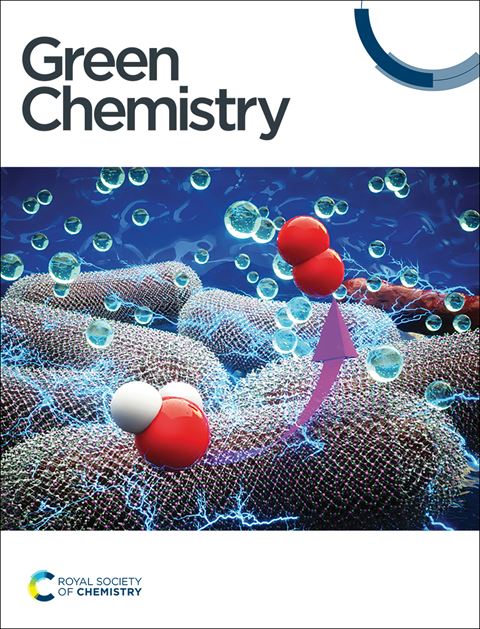A closed-loop zero-liquid-discharge process for the precipitative separation of all valuable metals from waste lithium-ion batteries of mixed chemistries at room-temperature†
IF 9.3
1区 化学
Q1 CHEMISTRY, MULTIDISCIPLINARY
引用次数: 0
Abstract
Recycling spent lithium-ion batteries (LIBs) and recovering valuable metals is essential for resource sustainability, minimizing environmental footprint, and maximizing resource utilization. However, many existing recycling methods are costly, energy-intensive, pose fire hazards due to organic solvents, or generate extensive secondary waste. Also, most studies have focused on metal recovery from simple cathode materials, such as LCO batteries, with less attention on mixed LIBs, containing multiple metals. To address these concerns, we have developed a room-temperature leaching process for NMC-type cathode materials that shows high leaching efficiency for Li, Co, Ni, and Mn (∼98%) under optimized conditions of 4 M acetic acid, 5 vol% H2O2, 20 g L−1 pulp density in a duration of 5 h. We have also developed a downstream process that enables the sequential and selective precipitation of all metals through judicious control of the solution pH and using specific reagents. As a result, all metal salts (Ni(DMG)2, Co8S9, Mn(OH)2, and Li2CO3) were recovered in pure form (≥98%) with high recovery efficiencies (85–99%). Additionally, excess acetic acid and the by-product sodium acetate (purity ≥97%) are also recovered, establishing a zero liquid discharge process. We also recycled Ni(DMG)2 complex to recover β-Ni(OH)2 and DMG for re-use. Furthermore, the recovered acetic acid was used to recover lithium, copper, and graphite from the anode material. This process offers several advantages over existing technologies, including low energy requirements for a room temperature process, eliminating cathode pre-treatment, the use of selective precipitation methods that preclude the necessity for organic solvents, and fire hazards. This environment-friendly zero-liquid discharge process offers a sustainable pathway for LIB recycling.
用于在室温下沉淀分离混合化学成分废旧锂离子电池中所有有价金属的闭环零液体放电工艺†。
回收废旧锂离子电池(lib)和回收有价值的金属对于资源可持续性、最小化环境足迹和最大化资源利用至关重要。然而,许多现有的回收方法是昂贵的,能源密集型的,由于有机溶剂造成火灾危险,或产生大量的二次废物。此外,大多数研究都集中在从简单的正极材料(如LCO电池)中回收金属,而对含有多种金属的混合锂离子电池的关注较少。为了解决这些问题,我们开发了一种nmc型阴极材料的室温浸出工艺,在4 M乙酸,5 vol% H2O2, 20 g L−1矿浆密度的优化条件下,在5小时的时间内,对Li, Co, Ni和Mn的浸出效率很高(~ 98%)。我们还开发了一种下游工艺,通过合理控制溶液pH值和使用特定试剂,实现所有金属的顺序和选择性沉淀。结果表明,所有金属盐(Ni(DMG)2、Co8S9、Mn(OH)2和Li2CO3)均以纯形式回收(≥98%),回收率高(85-99%)。此外,还回收了多余的乙酸和副产品醋酸钠(纯度≥97%),建立了零液排放工艺。我们还回收了Ni(DMG)2配合物,回收了β-Ni(OH)2和DMG进行再利用。此外,回收的乙酸用于从阳极材料中回收锂、铜和石墨。与现有技术相比,该工艺具有几个优势,包括室温工艺的低能耗要求,消除阴极预处理,使用选择性沉淀方法,排除了有机溶剂的必要性,以及火灾隐患。这种环境友好的零液体排放工艺为锂离子电池的回收提供了一条可持续的途径。
本文章由计算机程序翻译,如有差异,请以英文原文为准。
求助全文
约1分钟内获得全文
求助全文
来源期刊

Green Chemistry
化学-化学综合
CiteScore
16.10
自引率
7.10%
发文量
677
审稿时长
1.4 months
期刊介绍:
Green Chemistry is a journal that provides a unique forum for the publication of innovative research on the development of alternative green and sustainable technologies. The scope of Green Chemistry is based on the definition proposed by Anastas and Warner (Green Chemistry: Theory and Practice, P T Anastas and J C Warner, Oxford University Press, Oxford, 1998), which defines green chemistry as the utilisation of a set of principles that reduces or eliminates the use or generation of hazardous substances in the design, manufacture and application of chemical products. Green Chemistry aims to reduce the environmental impact of the chemical enterprise by developing a technology base that is inherently non-toxic to living things and the environment. The journal welcomes submissions on all aspects of research relating to this endeavor and publishes original and significant cutting-edge research that is likely to be of wide general appeal. For a work to be published, it must present a significant advance in green chemistry, including a comparison with existing methods and a demonstration of advantages over those methods.
 求助内容:
求助内容: 应助结果提醒方式:
应助结果提醒方式:


